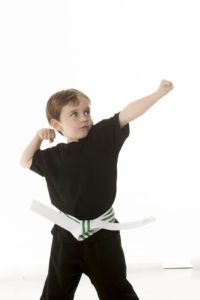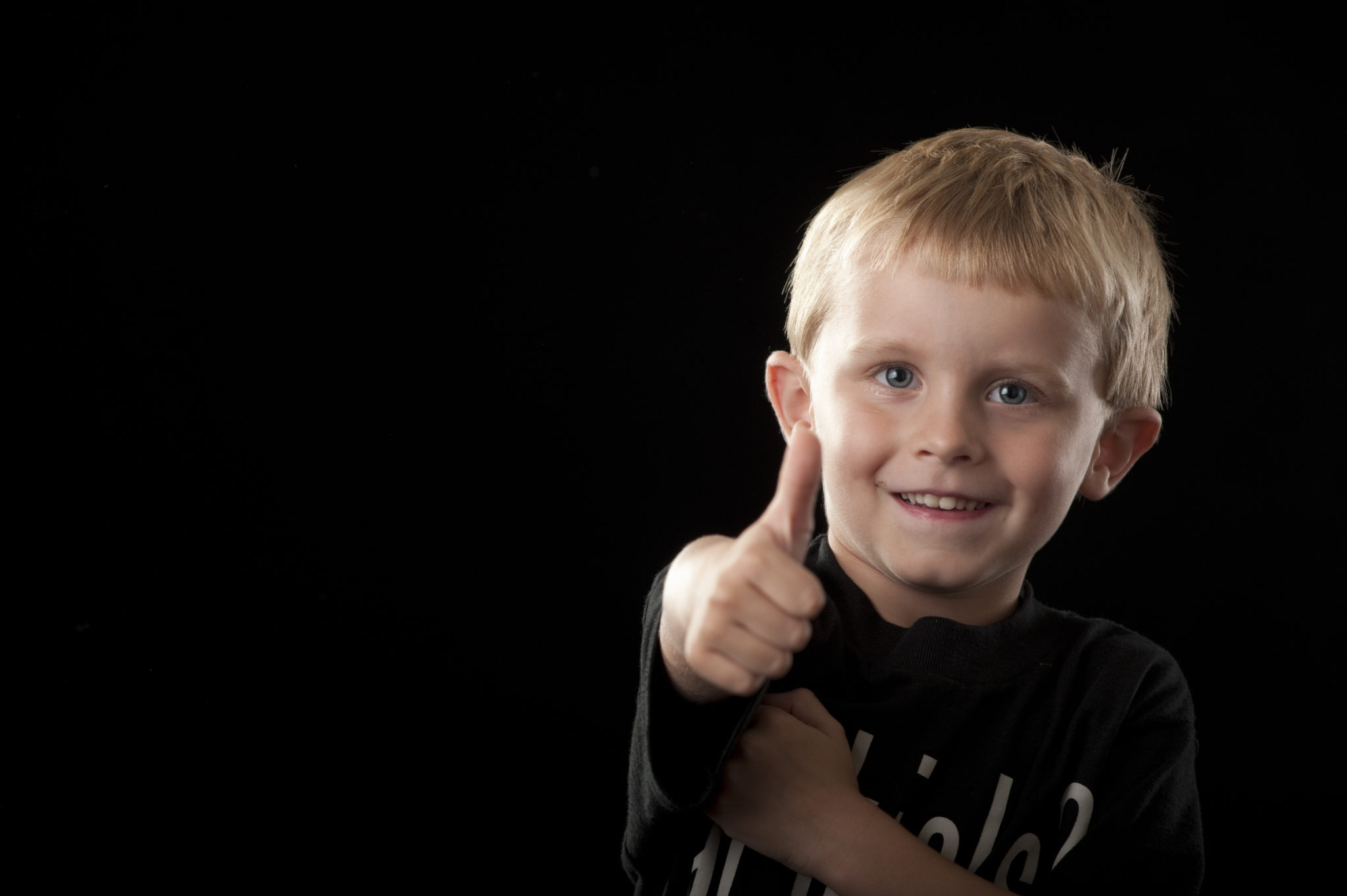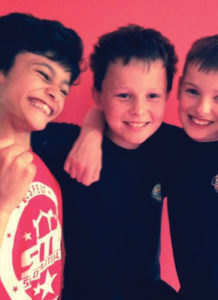Up until a decade or so ago, there were no martial arts classes for kids. Martial arts classes were taught the same way to everyone, regardless of age. While this level of training was terrific for older kids, or for younger kids who were anomalies (far above the expected stage of development for their age), it posed problems for the majority of kids, who would most often quit because the training was too hard. Instructors, in their frustration, would say the children weren’t ready, or worse, would blame the parents for letting the kids become quitters.
Then came a revolution in the kids’ martial arts world: Skillz Age-Specific Curriculum. Skillz uses a reverse training concept that completely changed the way we teach kids. Skillz looked first at the natural developmental expectations of children at each age, and then used the lessons of the martial arts to enhance what each child was already learning how to do.
Let’s look at an example that often raises questions from parents who have a more stereotypical expectation of what martial arts training might look like: the Early Skillz martial arts program for preschoolers between 3 and 4 years of age.
Developmentally, preschool kids between the ages of three and four years old love physical activity, and especially anything involving play. They have a fertile imagination and a strong desire to be less dependent on their usual caregivers.
The challenge we discovered is that many children at this age have a hard time with structure in a group environment, like what one commonly finds in most Martial Arts schools, or even many organized sports teams.
The solution we found is to provide preschool kids with their own martial arts program that targets their unique stage of development in a manner that keeps them entertained, while at the same time building skills that set them up for success. With that said, a structured program introducing early skill-based training in Martial Arts has proven to be very successful.
Within the Early Skillz martial arts program, parents see their kids working on typical martial arts exercises such as developmentally appropriate exercises, blocks, punches, and kicks. But there are also aspects of training that raise questions.

For example, after seeing their child go through our pre-evaluation process, and maybe watching a class in action, a parent might question why we spend so much time on skills that don’t directly relate to what they expect from a martial arts program. The answer is that our programs do not teach martial arts; they teach childhood development using martial arts as the vehicle for that development.
That said, each of the skills taught, even though it may not seem so at first glance, does have a direct correlation to martial arts ability.
Let’s look more specifically at a few of the skills taught in the Early Skillz program:
Running
When practicing the Running skill at the beginner level, kids are prompted to run forwards, backward, or sideways, while listening for the “Stop!” command from their instructor. While this does not seem very martial at first, there are both developmental and self-defense goals behind the skill.
- Developmentally:
- At age three, children tend to have a very jarring gait, falling from one step to the next. By mindfully practicing their running, kids can more quickly normalize their gait.
- One of the biggest complaints from parents of preschoolers is that the kids don’t listen. This perceived lack of attention can be a safety concern if a child runs in a parking lot, for example. The Running skill helps by training children to regulate their excitement and to listen for commands from authority figures while engaged in exciting activities.
- Sometimes, preschoolers forget where they are. The more exciting the activity, the more likely they will lose their relationship to their surroundings, including which of their friends might be in their path. By purposefully training how to focus their eyes on various targets while running, kids gain a greater understanding of how to remain aware of their environment and their place in it.
- Martially:
- While most 3-year-old children do not have to worry about physical violence, we can establish healthy fitness goals early on in life that will carry through future martial arts and self-defense training. As adults, we know that cardiovascular health is vital to martial prowess. A fighter who can’t breathe can’t fight.
- In the ring, we have to have a plan. To go into a fight or a self-defense situation and try stuff randomly leads to disaster. Knowing where we are and where we need to go, even when things get crazy, is extremely important.
- In addition to being able to move within a fight, a martial artist needs to be aware of the environment. Where are the exits? Where is the open space? Where are friends or foes? Much as the Running preschooler must be mindful of his friends and the walls, a fighter needs to be acutely aware of every aspect of the situation.
Hopping
At the beginner levels, a student in the Early Skillz class will work on hopping with their feet together while navigating over and through various obstacles.
- Developmentally:
- At the most basic level, kids at this stage of development are building their muscles and refining their ability to execute gross motor activities smoothly.
- In addition to merely learning how to use their muscles, preschoolers are working on developing the ability to coordinate what they can see with what the expected result should be. In other words, they are developing their eye-foot coordination.
- Vestibular development means that kids are working on their sense of balance. This includes their ability to sense the impulses from their inner ear, their ability to use visual input to recognize motion and position, and the ability to recognize subtle muscular cues.
- Speaking of muscular cues, the sense of proprioception is the awareness of our body’s position in space and in relation to itself. This sense is what allows us to touch our nose without looking. When hopping, we are working with the kids to not succumb to the tendency to move only with the non-dominant foot. We are coaching them to be aware of their movement patterns so they can keep their feet together.
- Martially:
- In the martial arts, a technique is only useful if it works. By using the same full-body motions as required in the hopping skill, kids develop the dynamic power needed to execute powerful kicks and decisive takedowns.
- In many martial arts, advanced kicking techniques require practitioners to leave the ground. By developing awareness of foot placement and power regulation, a martial artist can have better control and timing when attempting jumping kicks.
- When throwing an opponent, or being thrown, having control of oneself throughout the technique is essential, and many of the same dynamics the kids learn during the Hopping skill are the same as those used when throwing or being thrown.
Crawling
When practicing the Crawling Skill, a beginner student in the Early Skillz program will learn to bear crawl by using only their hands and feet (no knees), all while interacting with various obstacles.
- Developmentally:
- For kids at the preschool level, muscle development is happening at a rapid rate. Their bodies are transforming from that of toddlers to that of an adolescent. Bear crawls help kids build core and upper body strength.
- Along with their rapidly growing bodies, intellectual development sees significant advances at this stage of development. Along with language and critical thinking, we help the kids excel in following directions as they crawl. At this age, kids can typically follow one to two-step commands. By training to follow 3 to 4-step commands, we can help the kids exceed the developmental expectations.
- Until the age of 5 or so, kids struggle with any activity that crosses the centerline of the body, such as swinging a bat, drawing, and even reading. This somatic division occurs because the part of the brain that allows communication between the two halves, the corpus callosum, has not developed enough. By engaging in cross-body activities such as the hand and foot motions in the Crawling skill, the brain may actually develop even faster
- Martially:
- In many ground-based martial arts, such as Brazilian Jiu Jitsu or wrestling, the transitions from one position to the next use many of the same muscles and dynamic movements as the bear crawl.
- The same dynamic movement a child develops while crawling translates directly to the body movement required to throw powerful punches.
- Being able to punch across the centerline of the body, which develops with the growth of the corpus callosum, is vital for martial artists. It allows one to blade off, or turn one’s body to present a smaller target to an opponent, while also having a wide array of tools on both the left and right sides of the body to use against an opponent.
Catching
The Catching skill helps students work on hand-eye-coordination, spatial awareness, and teamwork. At the beginner level, an Early Skillz student at SOLO KIDS Studio will work on catching a ball thrown underhand from an increasing distance with each belt level.
- Developmentally:
- As children transition from being toddlers to preschoolers, their interactions with the world change, as well. While the toddler is learning the rules of cause and effect by stacking things up and knocking them down, the preschool child is starting to understand how things work and that they have a certain amount of control over themselves and their environment. However, they still do not have precision in their movements, which sometimes leads to frustration. The Catching skill helps kids better coordinate what they see with what they do, especially when it comes to eye-hand coordination.
- If you have ever played catch with a three-year-old, you will see they will “catch” the ball with their face before it drops into their hands. And when they throw it back, they launch it full force at your head. This is because they do not yet have the visual acuity to gauge distance accurately. In addition to having better control over their hands, the Catching skill helps kids build the motor skills and neurological pathways related to eye movement, distance calculation, and depth perception.
- Once kids develop their sense of depth, they can also begin to learn some serious mental physics. Consider how much math goes into calculating and predicting the path of an object based on the force with which it was thrown, its mass, wind resistance, and all of the other factors that govern movement in our universe. All of that gets done in an instant every time we throw a ball or try to catch that ball by applying pressure and deceleration forces. While most of us don’t think of these calculations when we play catch, the preschool mind needs to develop this ability, and they do so through playing games such as catch.
- Martially:
- In the martial arts, the ability to block, parry, or dodge an incoming strike requires timing, balance, and coordination. The better able one is to calculate the speed and angle of attack, the easier it will be to avoid being hit. As it would be inappropriate to throw punches at 4-year-old, we simulate this ability by tossing soft foam balls. This allows us to remove stress and fear from the learning environment, both of which have been shown to stimulate cortisol secretion, which inhibits memory formation.
- Some arts, such as Aikido, emphasize that we should never meet force with force; instead, we should learn to blend with and redirect an attack. In the same way that an Early Skillz student learns to catch a ball by intercepting its flight, then decelerating its velocity to bring it safely and smoothly toward the body, a martial artist could also intercept an incoming strike to redirect it in a safe direction.
- Timing is everything. No matter how strong one is or how graceful, if the right move done at the wrong time, everything goes awry. When the 3-year-old martial arts student is learning to catch a ball, they are also learning about when to move, how to be patient, how to anticipate. Whether it is an attack, a lobbed ball, or a business opportunity, a martial artist’s sense of timing is what allows them to execute every other aspect of training successfully
In any new adventure with your children, there will be some things that are as new to you as they are to your children (have you tried to help your older kids with their Common Core homework, yet?). In the SOLO Skillz programs taught at SOLO KIDS Studio Gosforth Newcastle upon Tyne, there is a lot of high-level science and educational best-practice layered within every lesson.
Our goal is to very literally rewire your child’s brain by using psychology-based teaching techniquesthat stimulate positive neurochemical reactions. This positivity helps kids feel supported while providing them the confidence they need to also become more independent.
Because we are focused primarily on boosting your child’s stage of development, the lessons in class can sometimes not be as apparent as simply learning to kick or punch. However, there is always a martial arts lesson to go along with the physical, intellectual, emotional, and social milestones we work through. If you are having trouble seeing how it all ties together, we encourage you to speak with any of our coaches. After all, there is a reason we refer to our team as Child Development Ninja Specialists!

For more information on Our Unique Age-Specific Child Development Program , arrange a chat with Child Development Coach – Sensei Dee
This Article was written by my good friend Michael A Evan who is also the Lead Consultant for Skillz worldwide and has helped us transform our children’s programs here a SOLO KIDS Only training Facility. A facility using martial arts as a vehicle for kids’ growth and success. We both share the same vision and philosophies when it comes to helping children succeed


